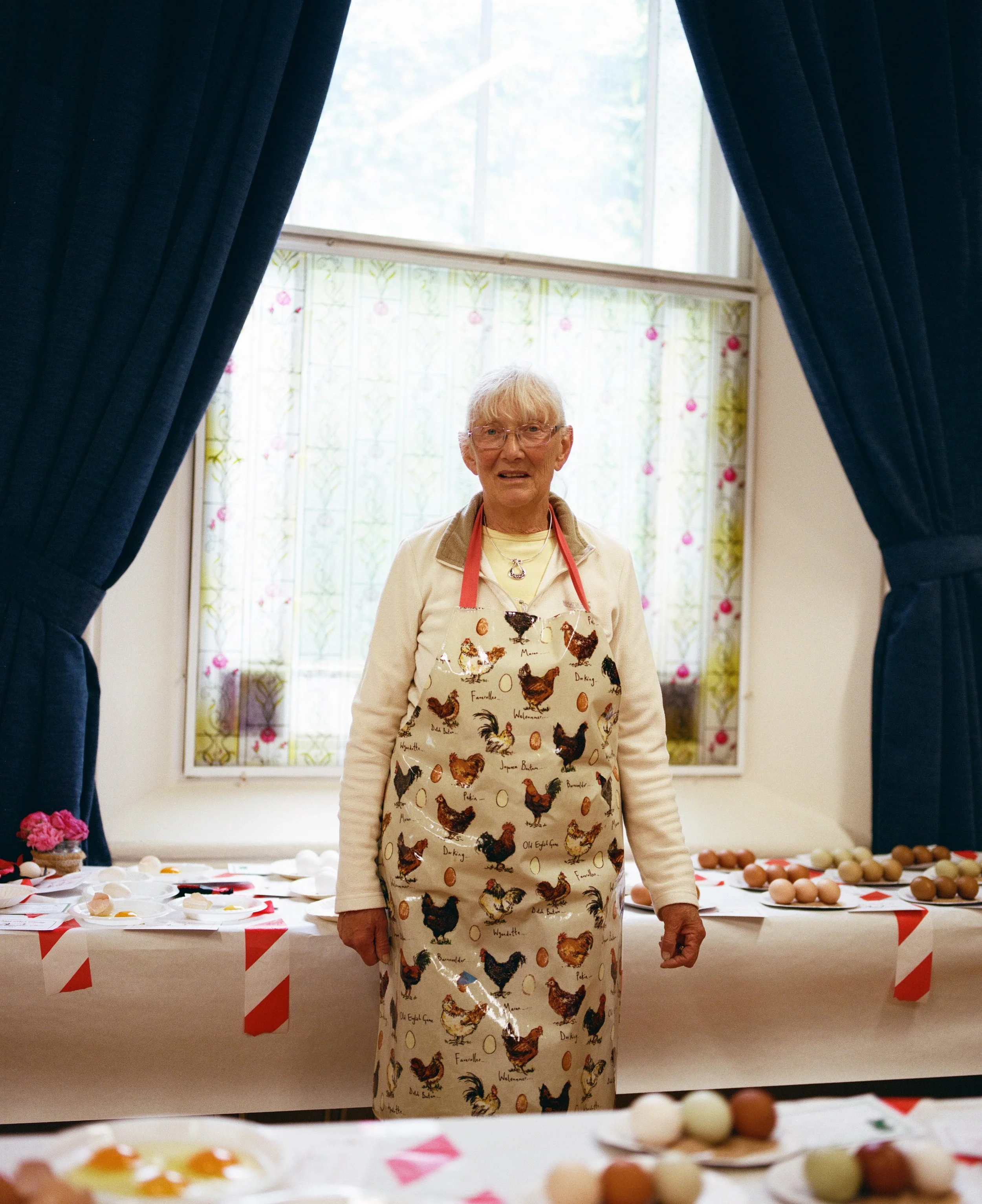High Peak Poultry Club. 3rd Championship Egg Show.
Trestle tables run in 4 lines the length of the hall of the Eyam Mechanics Institute. Placed on the tables are eggs. All shapes, sizes and colours. The eggs are arranged on plates of sand. The sand is presumably to stop the eggs from rolling around. Plates of 3 eggs, plates of 6 eggs, plates of more or plates holding just one single egg. Eggs that are white, eggs that are blue, a deep shade of olive green, pastel pink, dark brown and speckled. I am reminded of a colour chart for an eco-friendly paint company. The wording in the programme aligns with the visual metaphor; ‘Welsummer’, ‘Maran’, ‘French Maran’, ‘Araucana’, ‘Derbyshire Redcap’. I am overwhelmed and have never seen so many eggs.
The plates of eggs are separated from each other by strips of red and white tape which only adds to my confusion. Searching the programme for some kind of answer I learn that there are 80 categories in today’s egg show. Needless to say, this is too many to list here but some examples are Welsummer; 6 large fowl eggs. General Classification; 3 Large fowl eggs - Green/Olive. 1 Large fowl egg for contents. Waterfowl; 3 goose eggs. Decorated & Painted Eggs; Egg or Eggs painted - Any age. Deciphering the programme is in itself a large undertaking but there is nothing new going on here. Egg shows like this have been around since the Victorian ages and are a regular excursion in the rural springtime calendar.
It’s busy enough. There is a Sunday bustle in the hall beaten perhaps only by the hum of a jumble sale. There’s the occasional rattle of cups and plates from the kitchen where tea and cake are available. The tea and cake are worthy of the trip alone; tea and cake are germane to an egg show, these are the halls of the WI.
The judges weave through the crowd in white coats, the committee sit at the end of the hall in poultry club green fleeces receiving the results of the judges as they come in. There are stewards too and some of them have got skin in the game. The judges carry clipboards and an assortment of instruments to help them judge. Scales are used to weigh the eggs for the bantam class (a bantam egg can weigh no more than 42.5g). A rubber band on the scales stops the egg from rolling off. The ingenuity makes me giddy.
Over on the contents table, the judge has a purpose-built egg cracker. It’s a solid piece of wood shaped to the profile of a pitch-roofed house, it has rubber feet to stop it from slipping. I imagine when judging eggs one must take extra care. A proud judge tells me ‘My Father made this one, he copied it from one he saw years ago’.
The contents category scrutinises the inside of an egg and there are a number of factors to consider when scoring the insides. The judges first look for an overall freshness or ‘bloom’. This may seem arbitrary but there was indeed, when the eggs were spilt side by side a lustre in some that was lacking in others. One could compare it with the feeling you get when taking in a vase of flowers or eyeing a steak in the butcher’s window.
Next, there should be three distinct layers; firstly the yolk should stand proud and should be central to an albumen that holds a globular form. The third layer should be a shapeless excess spreading away from the main albumen form. Two pale white appendages protruding from the yolk signify healthy feeding tubes. Any blemishes, blood spots or discolouring are marked down. Yolk colour is important but can be easily enhanced with the right foods such as beetroot peelings and a corn feed which some judges feel gives too much of an ‘artificial’ look.
Birds used for the contents class will have been previously singled out by the owner as laying a consistent yolk. The bird will be kept separate from the brood, kept in a quiet, low-stress environment and fed a special diet for a week or two leading up to competition day. Today the hens are not here to enjoy their successes. That’s because APHA have ordered that hens and eggs are kept separate at public events in light of the increase in Avian Influenza.
The eggs judged in the shell are laid out in a uniform pattern with the pointed end facing into the table. In shape the judges are looking for an egg that has a well-rounded bottom, the tip must not be too pointy, and the egg should achieve symmetry. In a class of three eggs or more, each egg must be the same colour size and shape.
It’s not until you stand at the end of the hall taking in the eggs in the winner’s circle that you appreciate the grace of a fowl egg or a waterfowl egg. The eggs here truly deserve their place on the podium. They have a depth of colour, a rich sheen and satisfying curves, they are sublime eggs.
But as gazing along the isles I like the eggs with character the best. Textured shells, odd bumps and blemishes, wrinkles in the shell. Any stress on a bird shows in the shell of the egg or its contents around 3 days later. So the appearance of a fox near the coop, a thunderstorm, a heat wave or a change in the diet could all have ramifications on the final outcome. You can read the life of a chicken by the egg it produces.
I wonder about the uniformity of a supermarket egg, could I slip out and purchase a dozen ‘happy eggs’ from a faceless outlet and win the top prize? These eggs have predetermined form thanks to a strict regime of diet and drugs, artificial light and measured outdoor time. The threat of prey is virtually non-existent. A fox would need a high-level security pass to get into those facilities. The uniformity of a supermarket egg points to a life less lived and somehow feels more akin to urban living.
The eggs here show character. A life in the countryside, roosting in the coops of the peak district cottages where the only thing between the hen and the fox is a dry stone wall, where sleet can lash in sideways through the run even on a day in mid-spring.
The Judges call the results. The supreme goose egg is a two-time champion having won at the Ashbourne egg show three weeks before. Its owner says he kept it fresh wrapped in a damp cloth in the fridge. After today he says he’ll blow it to preserve it as a trophy.
I think of the supreme egg as the gold medal but another contestant corrects me. ‘Any fowl can lay one good egg, that’s easy. It’s the plate you want to scoop. 6 perfect eggs all the same colour, size and shape, that’s consistency, that’s the stuff of endurance. The supreme category is a sprint, a penalty kick, its a blaze of glory, and a plate of 6 is the true test.’
At the end pies from the local butchers are handed to the judges. The crowd and contestants mill around pointing out their favourites, discussing techniques and of course the restrictions of meets like this imposed by APHA in the wake of the rising fears of Avian influenza. It seems unjust that it’s not just foxes that threaten the health of small poultry farms and domestic rearers.
For now, everyone enjoys the competition within the four walls of the Eyam Mechanics Institute, protected momentarily from the outside where the stakes are much higher. "
Words by Sam Buckley
Photographs by Kat Wood









